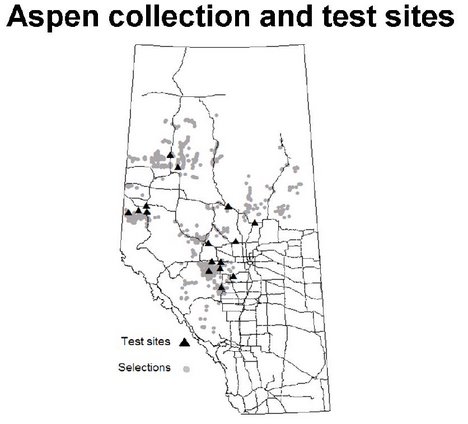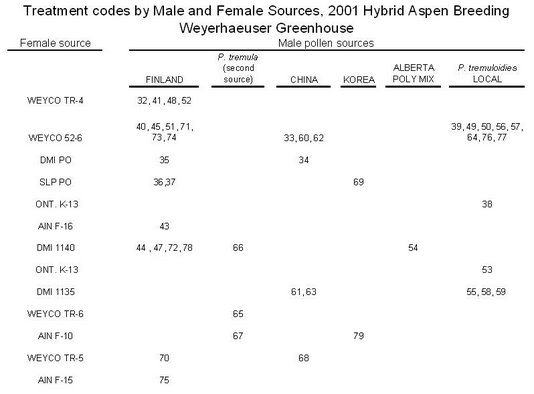Within the broader context of this program the following species have been crossed: P. tremula, P. davidiana, P. trumuloides, P. alba, P. grandidenta. However, with this study only female P. tremuloides has been crossed with male pollen of P. davidiana and P. tremula.
All the trial being analysis can be catagorized into three groups which are : Clonal , Hybrid, and Provenance
Clonal Material:
243 aspen trees were used in the various clonal trials. See graph below for source infomation.
In general collections where made in the boreal forest between range of: 52o to 58o latitude &
105o to 122o longitude. See mapfor selections across the provance.

There are a few selections from northern British Columbia and Saskatchewan that are not represented on the map.
Source information

Selected trees are picked from natural forested stands usually with the forest management area assoctiated with participating company.
Suckers from harvested roots are used to make clones which are used in the experiments.
At the start of study a more intensive tree selection protocal was used with comparison trees. In addtion to the comparison trees more information on trees and site were collected, however the forested areas suitable to meet criteria soon became limiting. New approach was adapted to just picking phenotypically good looking trees and only collecting information on height and diameter at breast height. This appraoch was more effecient resulting in more material entering into program. Assumption is wild seletions are influenced too much by their environment to be evaluated by feild assessment, therefore common garden experiment which control for environmental variance allows traits of interest, such as height, to be evaluated.
Breeding Material
Aspen is dioecious meaning each tree is either male of female, therefore breeding requires male pollen to be collected in vials and then artificially placed on flowering female reproductive structures called catkins. In nature pollination occurs predominantly by wind dissemination form male trees to females trees.
Pollen is Perishable and needs special care and handeling. If handeld carefully in can be collected and transported within breeding season as was the case for the pollen from China, Finland, and, Korea in this study.
see figure below for treatment numbers relative to cross type.
